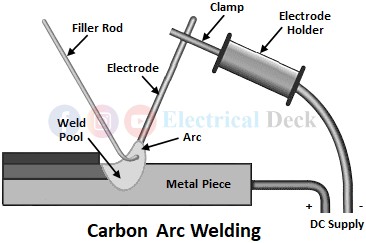Carbon arc welding is the first electric welding process invented by russian inventor Nikolay Benardos in 1881. In this welding method, an electrode made up of carbon or graphite is used to initiate an electric arc. The welding is done by heating up the metal pieces with the electric arc struck between the carbon electrode and the workpiece to be welded.
Carbon Arc Welding :
The below shows the arrangement of the carbon arc welding process. It consists of an electrode holder to which a carbon electrode is attached. The arc is maintained between the metal piece and the carbon electrode held in the holder. The arc is struck by touching the electrode with the metal piece momentarily and then taking away it at a definite distance apart.
The arc is allowed to impinge on the surface to be welded till a molten pool forms and then the holder is steadily moved along the joint. Filler metal and flux may or may not be used depending upon the type of joint and material to be welded.
In carbon arc welding, the electrode is usually connected to the negative terminal and the workpiece to be welded is made as positive. So that less heat will be generated at the electrode tip than at the metal piece because there is a tendency of fusing carbon particles from the electrode and mix in the weld which causes brittleness.
Thus dc supply is preferred for carbon arc welding since there is no fixed polarity in the case of ac supply. Generally, a voltage of about 30 Volts is used in case of in case ac supply and 40 Volts in case of dc supply.
Electrodes Used in Carbon Arc Welding :
In carbon arc welding electrodes made of carbon or graphite with a diameter of 2.5mm and a length of 300mm are used. Graphite electrode has more brittleness, hardness, and longer life compared to carbon electrode. They can withstand higher current densities but it is difficult to control the arc column.
Due to longer life and low resistance, graphite electrode is preferred over carbon electrode. The arc produced between the two electrodes heats the metal to melting temperature which is about 3200°c on the positive electrode.
The carbon or graphite electrodes used are generally non-consumable electrodes, thus there is a requirement for additional filler material if in case needed for welding which depends upon the type of joint and materials to be welded. Thus this type of welding is normally employed where there is no requirement for filler material. Even though the electrode is of a non-consumable type, vapourization and oxidization cause the electrode to disintegrate gradually.

